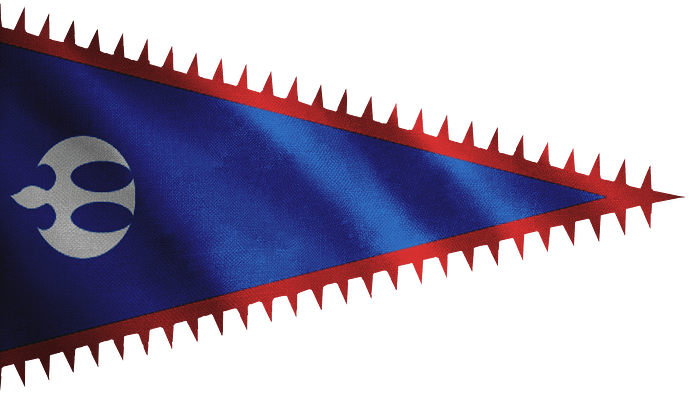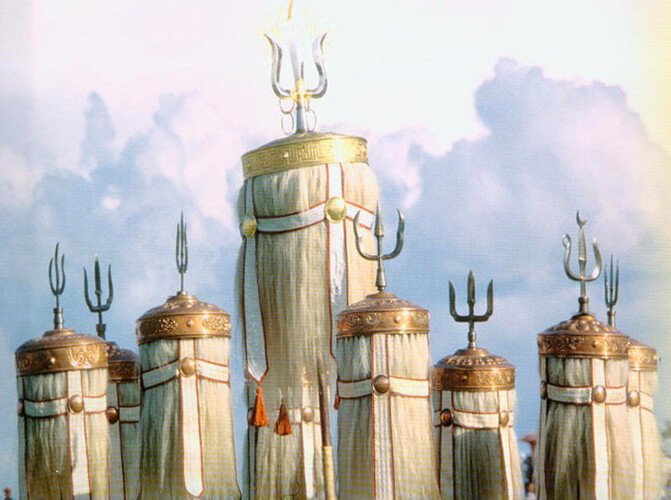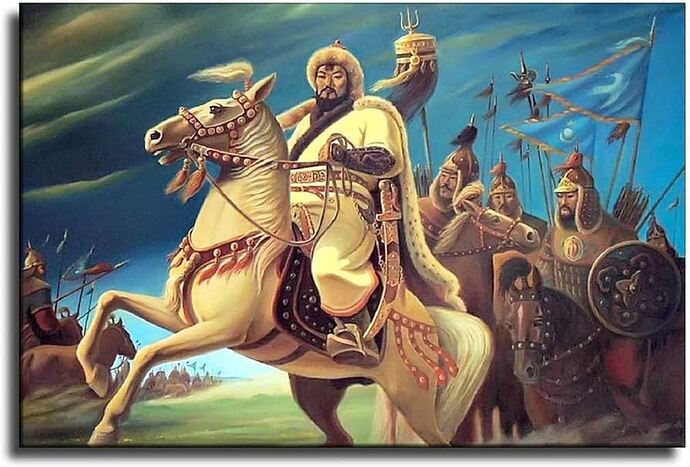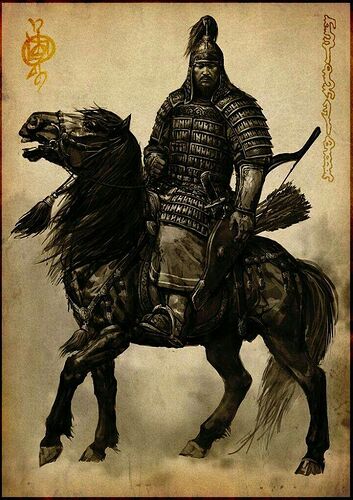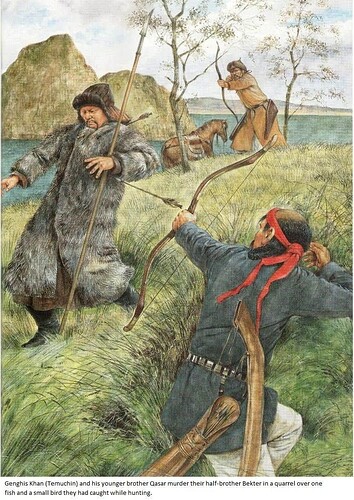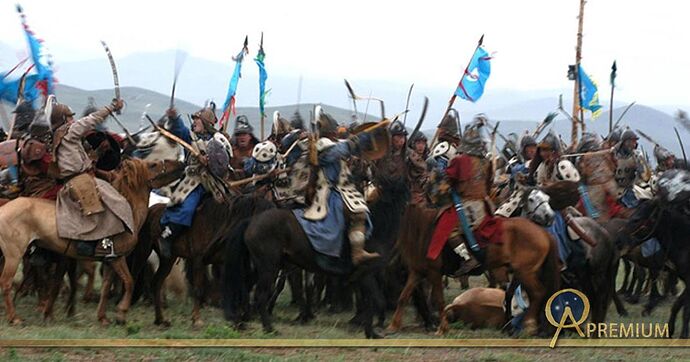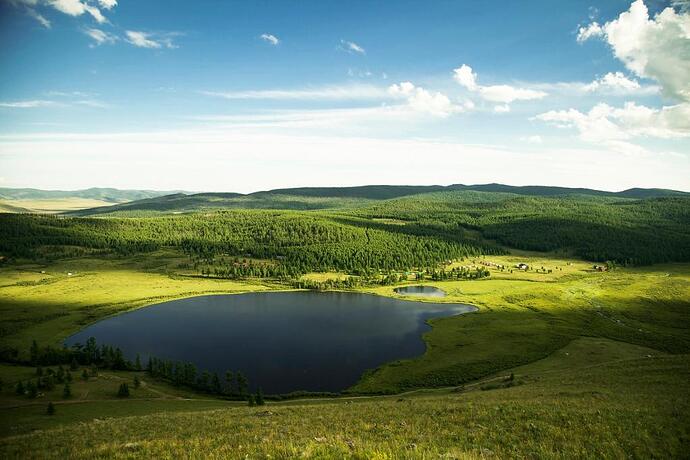Temüjin
1206-1227
1 man, 1 mission, 1 empire
Difficulty: 3/3
Bonuses
-
Unique cavalry Unit: Noyan
-
Unique Khan: Temujin
-
Unique Building: Khan’s Ger
-
Can call in off-map Forces.
-
The death of the Khan counts as Defeat.
Tribal Unification – The map is adorned with unique resources for the Mongol Temujin variant, Tribal Banners, which can be collected by Temujin. Collecting 9 White Spirit Banners reduces the time to Age up to Feudal Age. The Banners also act as Currency which can be used to buy Baljuntu Abilities.
The Khan is also able to place the Khan Black Banner, which serves as a Rally point when calling in forces from the Baljuntu. Where they will Spawn from the edge of the map closest to the Khan’s Banner.
Khan’s Ger will unlock Feudal Age automatically after 7 minutes. Each Spirit Banner claimed by Temujin will reduce the time to age. If the Khan’s Ger is packed, its Age Up time is paused.
Once Age Up is ready, one can choose between Deer Stones or Silver Tree to be called in.
Baljuna Covenant – Call in Temujin’s most loyal followers, the Baljuntu, by using either Unification Points or Currency (Stone).
Available in Dark Age:
-
Blood Bond: Call in a Noyon to assist Temujin’s rise to greatness. (can only be used once)
-
Hooves of the Wild/Raw Mongols: Call in a group of horsemen to assist Temujin in raiding settlements.
-
Guidance of Burkhan Khaldun: Khan’s Ger now provides an extra stone within Ovoo’s influence.
-
Steppe Falconers: Call in 2 scouts to assist Temujin in exploring new lands.
-
Khamag Warriors: Call in 3 Mangudai to assist Temujin in defeating his foes.
Available in Feudal Age:
-
Visions of the Tenggri: Call in a Towcenter followed a band of villagers to settle down in the new lands explored by Temujin
-
Call of the Ordu: Call in a band of Keshiks to fend off Temujin’s enemies.
-
Hunters of the Steppe: Call in a group of Mangudai to harass Temujin’s rivals
-
Guardsmen of the Khan: Call in a group of Spearmen to defend Temujin’s camp.
-
Gifts for the Fallen: Increases the yield given from Bounty, Temujin’s does not forget the families of the fallen warriors.
Available in Castle Age:
-
Council of Wise Men: Call 3 Shamans to help Council Temujin’s growing Khanate.
-
Songs of Battle: Calls in a Noyan and a group of Horsemen. When Temujin fires his signal arrow, it will also affect units within Noyans to influence Aura.
-
Iron Heroes: Call in a large group of Men at Arms and Keshiks to aid the Temujin conquest
-
The Great Nerge: Small bands of Horsemen and Mangudai will appear at all corners of the map, answering Temujin’s announcement of the great hunt.
-
Decree of Yasa: When a friendly unit dies within Temujin or a Noyan influence, nearby friendly units get an attack and movement speed buff by 15% for 3 seconds.
Available in Imperial Age:
-
Envoy to the great Khan: A pack of traders followed by a few Chinese Officials able to supervise Temujin’s growing empire shows up near the Khan’s Ger.
-
Khan’s Rallying call: An Army consisting of Mongol Cavalry is called into battle. (Horsemen, Keshiks, and Mangudai)
-
Friendship of Two, stronger than stone walls: Calls in a large siege army led by a Noyan. (Springalds, mangonels, Huihui Pao)
-
Unstoppable Ordu: Grants Temujin a new Signal Arrow ability, when used, the death of any unit under its influence will be immediately replaced to Reinforce Temujin’s frontline.
-
The Khan of Khans: Grants the Khan’s Ger ability to be rebuilt into a Wonder (at a cheaper cost of wonder)
Each White Spirit Banner rewards a Unification Point that can be spent in one of the Baljuntu abilities. Alternatively, each Baljuntu ability is purchasable for a 1000 Stone.
Landmarks:
Feudal Age:
- Deer Stones
- Silver Tree
Castle Age:
- Steppe Redoubt
- Kurultai.
Imperial Age:
- White Stupa
- Khaganate Palace
Wonder:
- Great Tent of Chinggis Khan
Unique Buildings:
- Khan’s Ger:
Serves as a Landmark and Functions as a Normal Ger, but also as a default Spawn Point for the Baljuntu.
Certain Baljuntu will always spawn in front of the Ger.
Will automatically start progressing towards Feudal Age as long as it is unpacked.
Also has a much faster movement speed when packed compared to other packed Mongol Structures. And will slowly repair itself when out of combat.
When the Universal Khan is unlocked in the Imperial Age, this building can repurpose itself into a Wonder.
When Packed it is also able to construct Ovoo’s at stonecrops.
- Black Banner:

Deployable structure by Temujin, serves as a Rally point for the Baljuntu.
Can be easily destroyed by enemies if found.
A maximum of 3 banners can be deployed, if there are no Banners, then the Khan’s Ger will act as Default.
Note: The way the banner and baljuntu call in the system work is when you select a Baljuntu, you have to select on the map where to “deploy” it, so say next to the Khan, or at a relic site on the map.
The game will take reference to the nearest black banner and spawn the off-map units from the edge of the map closest to the Black Banner Rally point relative to where on the map you decided to deploy it.
So if you have a banner south of the map, and want to deploy some units down south, the units will spawn at the edge of the map from the south. However, if the banner is missing and the Khan’s Ger is located west of the map, the units will come in from the west edge of the map, and move towards the point in the south you chose to deploy them.
- White Spirit Banner
Is a unique resource that can be collected only by Temüjin, spread around the map, grants Unification Points when claimed.
Can also be spotted out by enemies but not claimed or destroyed.
Unique Units:
Temujin:
Hero Khan unit with the ability to pick up White Spirit Banners that will aid in quickening to age up time to feudal age and purchase Baljuntu call inn with Unification Points gained by the White Spirit Banners.
Also has a set of unique skills:
-
Black Banner: Functions as a rallying point for the Baljuntu, and can place 3 such banners around the map. When selecting the placement of the Baljuntu, they will appear on the edge of the map closest to the Black Banner or the Khan’s Ger.
-
Reinforcement Arrow: Fire’s a signal arrow that when a Unit under its effect dies, is immediately replaced by a new one that will be rallied towards the nearest Black Banner.
-
Incindiary Shot(Passive): Temujin is able to do Tortch damage on buildings with ranged attacks
Noyan (180F 60G):
A Unique Mongol support unit that can switch between Ranged or Melee attacks and serves as a Proxy-Khan that boosts nearby units with 10% movement speed, +1 attack, or +1 armor.
Counts as a Heavy Cavalry and is affected by Keshik and Mangudai upgrades. Respective upgrades only effecting its Melee attacks or Range attacks.
Via the Songs of Battle friendly units within the Noyan’s Aura will gain the same Signal Arrow effects that Temujin calls upon when used.
Unique Technologies:
Whistling War Arrows (Age II 150W 200G): When a Mangudai shoots, it reduces the Attack Damage done by nearby units by 20% for 2 seconds.
Orders in Rhyme(Age III, 250F 250G): Increases the Size of Noyans Aura
War Shamans (Age IV, 300F 200G): Shamans now ride on Horses and can keep up with Temujin’s mobile army.
Wonder:
Great Tent of Chinggis Khan.
Unique Unit:
Temujin:
Health: 110/200/270/330
Attack: 2/3/6/24(Ranged)
Rate of fire: 1.88 (Ranged)
Range: 5.5 tiles (Ranged)
Armor: 0/0/0/2
Pierce Armor: 0/0/0/2
Speed: 1.62
Noyan:
Health: 110/200/270/330
Attack: 10/19/24/29 (Melee), 5/6/7/10 (Ranged)
Rate of fire: 1.38 (Melee), 1.58 (Ranged)
Range: 3.5 tiles (Ranged)
Armor: 2/4/5/7
Pierce Armor: 2/4/5/7
Speed: 1.63
Note: Can have up to 4 Noyans in the field.
Write-up (Warning, Long Story ahead):
If they can make a Civ Variant focused around a single person who had impacted a nation’s history in only 3 years.
Then there is a single person whose entire life span is most definitely worth telling from the beginning to the end.
Let me tell you the story of one such person, with the very plain ordinary name of Smith, or known within the local region’s language: Temujin.
Temujin’s life wasn’t one born into greatness, other than holding a blood clot in his hand when birthed by his beloved mother Hoelun. Which was foretold as a symbol of greatness by the local Shaman.
Temujin’s life was anything but easy. His father Yesugei, although an important tribe member, died during Temujin’s early childhood, which resulted after consultation with the tribe to expel his family out of the tribe to fend for themselves. Hoelun through the sheer willpower derived from motherhood, was able to scrounge off the land and provide for the family with the help of Temujin and his brothers going out fishing and hunting small games.
Temujin and his family had to struggle through hardship, only made worse when it was discovered that his half-brother Behter was stealing food from others, and the fact that he was eligible to inherit everything once he came to age, Temujin and his younger brother Khasar conspired together and killed their half-brother Behter.
This of course enraged their mother Hoelun, and the rumor of the murder spread across the steppe, which eventually led the Taychiud tribe to seek out Temujin, captured and punished by being placed in a wooden cangue, he was held out to be displayed for humiliation and to demonstrate the ascendency of the Taychiud over the Borjigon, punishment of Behter’s murder.
However, not everyone liked the decision and found the judgment to be just. One such family was that of the Sorqan Shira, who showed Temujin mercy, helped him escape, and provided him with a horse and a bow, and some provisions of food.
The Taychiud being Temujin blood relation had shown him nothing but cruelty, but he found compassion and loyalty among the common herders. This was something that would be ingrained into Temujin’s memory, and he would not forget the deeds of the Sorqan Shira.
As time went on Temujin not only survived by started to make his connections.
He soon found his first follow Bo’orchu, and closely after Jamukha who would become Temujin’s closest friend and whom he became Blood brothers with.
Temujin and Jamukha by Phobso
Soon after he grew old enough to finally wed his wife Borte promised and arranged long ago by his deceased father Yusugei. Borte’s family gave Temujin’s mother a black sable coat as a dowry, which Hoelun gave to Temujin as a gift to introduce himself to Toghrul, Khan of the Kereyit. A powerful tribe that has been Anda, an Oath to Temujin’s father. In Steppe Nomad culture, it was customary to gift a fur coat from the bride’s family to the father of the groom, however, the father of Temujin was already dead and Hoelun advised Temujin to seek out Yesugei’s long-time friend and ally, Toghrul, and give the fine sable coat to him.
Toghrul was so moved by this offer from Temujin that he didn’t hesitate to accept Temujin as a follower and a part of his family, under the protection of such a reputable Khan, Temujin started to amass more followers, however, the news of the marriage between Temujin and Borte reached the Merkit tribe, where his mother Hoelun originated from as she was stolen by Temujin father.
As revenge, they decided to attack Temujin, Temujin camp managed to spot the oncoming raiders just in time and managed to escape, however in the chaos and confusion of escaping from the Merkit, Borte, and a few servants got captured by the Merkit, and having driven Temujin away from everything he once had, forcing him to hide in the holy mountains of Burkhan Khaldun.
Distraught, Temujin had seemingly lost everything, and not for the first or last time.
He decided to seek guidance in the mountain and eventually came back to Toghrul for aid, who agreed in anticipation of plunder but was also enraged that the Merkit had attacked someone under his protection. So he re-introduced Temujin to his blood brother Jamukha, who had become Khan of his tribe but also had an eerily similar hardship to Temujin, having been captive by the Merkit and gone through slavery, he had also managed to escape and built his following.
Eager to exact revenge, Jamukha didn’t hesitate to join Temujin in the attack on the Merkit tribe.
The raid was a success and Temujin was reunited with Borte, and a strong bond was formed between Jamukha and Temujin.
However, due to the difference between the leadership between Temujin’s Meritocracy and Jamukhas Traiditonalism, these two close friends would eventually have to go their separate ways, as their ideals would become more and more conflicting.
When Temujin decided to split off from Jamukha to Temujin’s surprise, some of Jamukha’s family and men had decided to follow Temujin, the closest living relatives of the Khamag Khan, on account of a vision of Temujin’s future greatness. Due to this, eternal friction between the two once close friends who considered themselves brothers would take place.
When Jamukha’s younger brother Taichar was killed by one of Temujin’s herders while stealing horses, he took this as an act of war. He mobilized thirteen tribes at his command against Temujin, Temujin’s small army still fresh in military command, was easily defeated, forcing Temujin to flee once again. Jamukha decided to display his power by terrorizing his foes, boiling some of the prisoners of war in cauldrons, and tying a noble’s head on the tail of a horse which is seen as a great offense in Mongol culture. Which led to the desertion of Jamukhas forces.
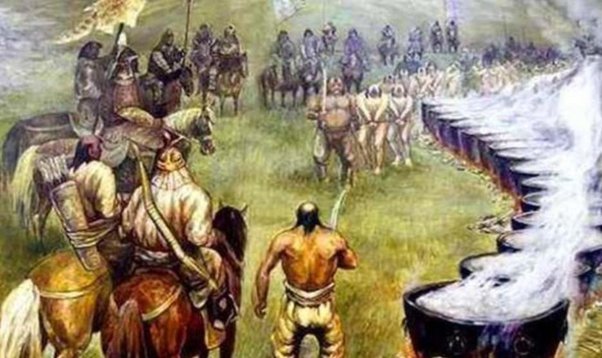
The next 10 years of Temujin’s life remain a mystery, some say he sought refuge in the nearby Jin Dynasty, an act not uncommon by steppe leaders, but was seen as rather shameful, rumors have it that he was taken as a slave once again by the Jin, but managed to escape. This is also perhaps why Temujin also sought complete destruction of the Tangut before he died, as this part of his life might have been recorded in the Tangut scriptures. Or perhaps he simply that he was on the constant run and building up the forces once again, remains a mystery today.
Regardless, when Temujin returned from his hiatus, he was working alongside the Jin Army and Toghrul to fight against the Jin’s former allies, the Tatars.
They were both granted the title of Wang(Prince) by Jin, Mongolized as Ong, hence often referred to as Ong-Khan.
Temujin and Toghru set about raiding to expand their power, ending up attacking the Merkit in a devastating raid, where Temujin gave most of the loot to Toghrul, even though Toghrul attacked the Merkit again the following year and did so without informing or sharing the loot with Temujin.
Now they were strong enough to attack the Naiman tribes, after the death of Naiman Khan, and being led by two antagonistic sons considerably weakened the Naimans, a golden opportunity for Temujin and Toghrul to strike at the Naimans. Even though internally the Keriyit clan which belonged to Toghrul tried to split Temujin and Toghrul apart, it failed as Temujin happened to have rescued Toghrul’s son, Senggum Ilka from a Naiman army, however, the seeds of dissent were already sown. Temujin’s organizational structure based on Merit, did not endear him to the traditional old nobility. Many of Temujin’s generals and people of high position were descendants of commoners such as herders or even slaves, such as Mukhali of the Jalayir who became one of Temujin’s most trusted and greatest generals.
Eventually the enemies outside united and elected a charismatic leader, no other than Jamukha, the Naiman, Merkit, Tatars, Taichyud and many other subgroupings of vassal tribes made a coalition and appointed Jamukha as Gur-Khan, Universal Ruler.
The armies met at Koyiten, where Temujin and Toghrul managed to defeat the coalition forces,
The enemies splintered, and various tribes, fled in their own directions, Jamukha decided to raid the camps of his own allies and Temujin went after the Taychiuds, his blood-related clan, to exact final vengeance upon them for what they had done to him before.
He killed all the leaders of the clan but remembered the family and people who had shown him mercy, and absorbed them into his own addition.
He then went after the Tatars, the enemies of his father.
He gave strict orders to not loot until the enemies had been completely defeated, to prevent any Tatars from escaping. The Tatars were soundly defeated, rounded up, and executed, and the women and children spread among the Temujins people.
Temujin’s orders meant army discipline was held, not broken by individuals running off to plunder and Temujin made it so that loot could be collected and redistributed among everyone equally, and made sure Families who had lost warriors, still received the rewards, helping them to strengthen the entirety of the his clan, but also preventing anyone ended up having to struggle to make ends meet and live through the same hardships Temujin himself had to go through in his childhood.
This also meant the people had nothing but the utmost loyalty towards Temujin.
When three of Temujin’s relatives had decided as a right of nobles to start looting ahead of everyone, Temujin confiscated and distributed what they had taken and punished them for disobedience.
Which led to their desertion.
By now, Toghrul was aging, and Temujin was dominating eastern Mongolia, many were wondering who would succeed Ong-Khan Toghrul. Temujin seemed the most logical choice, and it was suggested that Ong Toghrul’s daughter Jochi marry Temujin. This greatly alarmed Toghrul’s son, Senggum Ilka, who wanted the inheritance himself, despite Temujin having saved him from the Naimans. Here Senggum Ilka found common cause with fellow aristocrats in Toghrul’s service, such as the newly arrived and very angry, the very relatives who deserted Temujin from having redistributed their loot.
Eventually, they managed to convince Toghrul feeding into his fear of losing his throne, which had lost several times over his long life mostly to his brother Jagha Gambu, and often had to reclaim it with the aid of Temujin. At a Late age, it seems to have become a particular fear of him to lose it again while death was creeping closer to his old age.
Toghrul planned a trap for Temujin, by agreeing to the wedding of his daughter Jochi, to draw him in unarmed, but a pair of sympathetic herders learned of the scheme and managed to alert Temujin while he was en route, frustrated by this failure, Toghrul combined forces with Jamukha and attacked Temujin in the Qalqati Sands. However, yet again Temujin managed to escape, perhaps due to them stopping by Temujin camp to pillage rather than giving chase.
Temujin and his survivors withdrew to Lake Baljuna, and once more, Temujin had lost everything he had accomplished in the last 40 years of his life. But this time he was not alone, his followers swore oaths of loyalty to him, and they would be known as the Baljuntu, and would remain in great honor under Chinggis Khan.
Temujin reputation for fairness and meritocracy had spread among the steppes, and simple herders came to provide sheep and aid to Temujin at Baljuna, including the father of a young boy named Subutai.
With his forces trickling in, Temujin had renewed vigor, defection from the enemies revealed the fragile state of the anti-Temujin forces were, Temujin sent out messengers to lead figures with remembrance of past promises and loyalties, sowing dissent and intrigue. As the Coalition fractured, Temujin marched and under cover of a knight, fell upon the Keriyit during a feast. Toghrul and Senggum fled during the chaos as he had with the Tatars, Temujin incorporated the survivors and strengthened his force, rewarding both friends and foes who had shown bravery in battle.
Old Toghrul fled to the Naiman, but a Naiman patrolman killed him, refusing to believe that pitiful wretch was once the mighty Ong-Khan.
Now Mongolia was divided into Naiman under Tayang in the West and Temujin in the East.
All the forces who were against Temujin had now fled to rally under the Tayang banner, who now had the Merkit and Jamukha, as well as any other dissidents who did not want to be subjugated under Temujin’s rule and law.
Tayang encouraged the Onggud in the southern borders of Temujin, to attack from south alongside them, however, the Onggud decided to alert Temujin about these plans, which caused Temujin to lead a force unexpectedly early in the year, when Naiman patrolmen saw the forces of Temujin, at night every soldier lit extra fires to make it seem their army was greater in numbers. Leading the patrolmen informing about greatly inflated numbers. Tayang was greatly concerned about this message and wanted to withdraw, however, his honor was challenged by his wife, son, and generals who accused him of cowardice, so he was forced to advance, at Naqu Cliff the armies met and the great final battle of Mongolia took place. It was said that Jamukha had frightened Tayang with stories about Temujin’s ferocity and brutality, before abandoning him.
Tayang and his army were surrounded in the mountains, and in the morning anyone who hadn’t surrendered was killed. Few including Tayang’s son managed to escape, but Tayang himself fell in battle.
After the battle, the Khanate of Temujin was established throughout the eastern and western steppes, and the time was spent hunting down the remnants, pushing them further to the west.
Jamukha who had been hiding the mountains in an ironic twist of faith, was finally betrayed by his final five followers and brought before Temujin. And for Betraying their master, Temujin had the five followers executed.
And in the final scene of the secret history of the Mongols. Temujin urged Jamukha to rejoin him as a companion.
But Jamukha simply asked him to give him a bloodless honorable death. As he explained to Temujin that if he was to be kept around, he would only be a louse in his collar, a thorn in his coat, and continue to cause him trouble.
In the Secret History of the Mongols, Temujin reluctantly without protests, the execution of his old friend, in popular tradition, Temujin buried him with the golden belt Jamukha had given him, back when they had sworn themselves as Blood Brothers for the third time in a big official gathering between Temujin and Jamukhas clans and traded golden belts, key symbols of a Mongol man’s identity.
Now, Temujin was the undisputed ruler of the people north of China, he held a Kurultai at the Onan River, where they hoisted the white standard with nine tails, Temujin was proclaimed Khan of all the people in the felt tents, taking a new title: Chinggis Khan. (Firm/Stern Ruler).
With his rule secured, he reorganized the entirety of Mongol society, rearranged tribes into decimal units commonly known as Tumens, removed vestiges of power of the old Khans, and broke tribal ties, placing the new Khan at the head.
With new laws, the Yassa, standardized and reordered them and provided a clear code of conduct to reduce infighting and appease the spirits. They were drilled in new military techniques and prizing discipline and strong command over all else.
And this is what separates Chinggis Khan from many, He was not born great, nor was greatness simply granted to him, he had to grind hard for it. He had tried to live a peaceful life minding his own, but it was denied to him, he knew the only way to achieve “true peace” in the steppes, was to conquer it and end the cycle of the constant fighting among the steppe tribes.
He grew up from mere nothingness, escaped death, and rose to power, only to lose it and have to repeat it all, several times, eventually leading to his greatness unlike anything the world had seen before, and his legacy still lives strong to this very day, and still shapes the national identity of Mongolia today, close to a thousand years since he was first born.
Not only that, I think that Temujin’s life story is a great motivational story for anyone struggling through the harshness of life.
It also shows that it is never too late to achieve anything in life.
The Great Chinggis Khan started his world conquest as a middle-aged 40-year-old man! His youth was filled with strife, sorrow, and a desperate struggle for survival, and had to experience losing all the hard-earned things in his life to start all over again from scratch.
Next up:
Hmmm, I don’t know yet.
Extra notes:
This post came out a bit different than usual, as I wanted to tell the story of Temüjin, the rise of Chinggis Khan and a story I find fascinating and motivational.
The Idea behind this Variant of Mongols was to try to emphasize more the play and usage of Movable buildings, try to reflect Temujin’s life story as a gameplay, and encourage some dark age play and aggression.
If the opponent is aggressive, he should be able to significantly delay the progress of Temujin, in a sort of Cat and Mouse game, where Temujin has to constantly move his Ger and try to “hide” it from the enemies, at the same time Temujin has to fend off any early attackers, and collecting the White Banners found randomly around the map, but spread out.
Once the feudal age hits in, the opponent should be wary of any ideal base location, as Temujin is then able to establish a base on a solid foundation, ideally near rich gold veins or stone croppings.
The opponent should also keep an eye out for any Black Banners cleverly placed, most likely hidden inside stealth forests, to prevent being suddenly harassed by Temujin forces from an unexpected angle, unless you want to build an AI base, surrounding your town with walls from all directions.
As the game goes on, Temujin’s play turns more and more into conventional Mongols in terms of Base buildings.
However, with smart usage of the unique unit, Noyans can lead multiple armies and preferably strike from several angles.
Temujin is designed to be more focused on the actual battles and macroing, and not so much on the Macro and eco level, although that itself will always play an essential role.
The fact that the Loss of Temujin means that you will lose the game, forces the player to think hard about how to use the Khan.
The use of banners will encourage trying to keep Temujin on the move and roaming around the map Refreshing placements finding new angles of approach and keeping the focus on very aggressive gameplay.
Well, that is my initial thought behind the design.
All of this got inspired me through a shower thought while thinking about Jeanne d’Arc.
For reasons… Don’t ask why.
If you liked this Civ Concept and want to see more, check out my other threads:
Southeast Asia:
East Asia:
The Jurchens - Jin Dynasty (Chinese Variant) Temujin - Mongol Variant ← You are Here
Europe:
Middle East:
Nizari Emirates - The Order of the Assassins
Crusader States - The Order of Templars
Mesoamericans:
